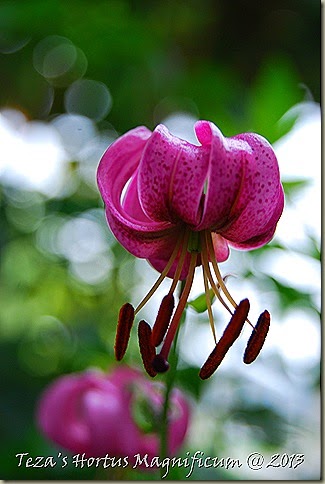
For those unfamiliar with the term, and while its not even remotely associated with anything Monty Python, it does refer to the fact that there exist, within the vast arena of botanical wonders, certain plants that are extremely difficult to locate! Add to this conundrum the fact that many of these same plants are also extremely difficult to cultivate in a garden setting, and you get a better understanding of the title of this post!
 I wrote about my recent acquisition of Deinanthe bifida here, and causally mentioned the beguiling beauty that is the topic of this post, Deinanthe caerulea. I was hesitant to add it to my repertoire, having taken account of its potential size at maturity, but on a recent nursery crawl to Lost Horizons, where the two photographs were taken, I thought to myself: ‘When have you ever complained about size before?’ Okay that time, but we’re talking plants here people!’ Needless to say, a delightfully robust pot came home with me, and is now in the thralls of blooming!
I wrote about my recent acquisition of Deinanthe bifida here, and causally mentioned the beguiling beauty that is the topic of this post, Deinanthe caerulea. I was hesitant to add it to my repertoire, having taken account of its potential size at maturity, but on a recent nursery crawl to Lost Horizons, where the two photographs were taken, I thought to myself: ‘When have you ever complained about size before?’ Okay that time, but we’re talking plants here people!’ Needless to say, a delightfully robust pot came home with me, and is now in the thralls of blooming! Deinanthe caerulea was first discovered after the turn of the twentieth century by Irish physician and noted plant hunter Augustine Henry in Hubei Province, China. First glance led to skepticism that this way anything great – mistaken as simply a continental population of lesser cousin D.bifida – but upon closer examination it was discovered to be a species unto itself. Deinanthe caerulea is quite distinct and is extremely difficult to locate in hort commerce.
 Taxonomy aside, Deinanthe caerulea is an exquisite woodland plant and a prize often sought by woodland plant enthusiasts and connoisseurs alike. The coriaceous, rich green leaves are produced in pairs along 38cm stems that terminate in lovely clusters of nodding, lilac suffused flowers, each with a gorgeous assemblage of lavender grey stamens crowded inside. Fellow plant hunter Reginald Farrer described the flower colour as being ‘sad, pale violet,’ though, as Daniel Hinkley emphatically stated: ‘I can hardly say that I find sorrow when this species blooms in my woodland!’ Sorrow indeed! Like other ‘shy’ woodland plants, it requires those wishing to admire its blossom to bend or kneel in order to fully appreciate! Hell I was lying prostrate on the ground in order to get these candid shots, but then again, this is nothing new for me!
Taxonomy aside, Deinanthe caerulea is an exquisite woodland plant and a prize often sought by woodland plant enthusiasts and connoisseurs alike. The coriaceous, rich green leaves are produced in pairs along 38cm stems that terminate in lovely clusters of nodding, lilac suffused flowers, each with a gorgeous assemblage of lavender grey stamens crowded inside. Fellow plant hunter Reginald Farrer described the flower colour as being ‘sad, pale violet,’ though, as Daniel Hinkley emphatically stated: ‘I can hardly say that I find sorrow when this species blooms in my woodland!’ Sorrow indeed! Like other ‘shy’ woodland plants, it requires those wishing to admire its blossom to bend or kneel in order to fully appreciate! Hell I was lying prostrate on the ground in order to get these candid shots, but then again, this is nothing new for me!
Hardy between zones 4-8, successful cultivation requires a shaded position with adequately moist and rich edaphic environments. Deinanthe is exasperatingly slow to increase in cultivation, but dormant buds are known to succeed if they are removed from the mother plant and planted independently. Little seed is set under cultivation, due in large part to the paucity of distinct clones that are grown in gardens, division is the likeliest method of propagation. Those looking to add this true Holy Grail selection should check Lost Horizons woodland nursery in Acton, Ontario.
































No comments:
Post a Comment